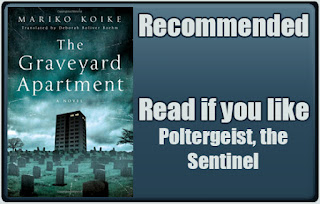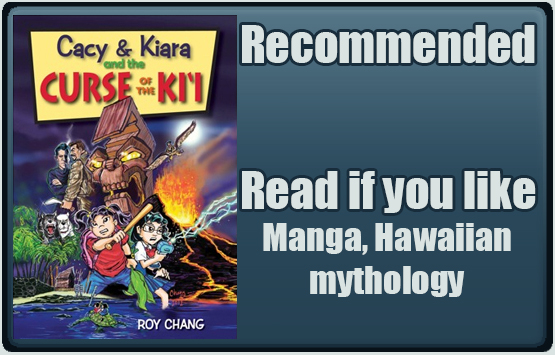Formats - Print
Publisher: St. Martin's Press
Genre: Ghosts/Haunting, Thriller
Audience: Adult
Diversity: Japanese characters
Takes Place in: Japan
Blurb:
| A terrifying tale of a young family who move into an apartment building next to a graveyard and the horrors that are unleashed upon them. One of the most popular writers working in Japan today, Mariko Koike is a recognized master of detective fiction and horror writing. Known in particular for her hybrid works that blend these styles with elements of romance, The Graveyard Apartment is arguably Koike’s masterpiece. Originally published in Japan in 1986, Koike’s novel is the suspenseful tale of a young family that believes it has found the perfect home to grow in to, only to realize that the apartment’s idyllic setting harbors the specter of evil and that longer they stay, the more trapped they become. This tale of a young married couple who are harboring a dark secret is packed with dread and terror, as they and their daughter move into a brand new apartment building built next to a graveyard. As strange and terrifying occurrences begin to pile up, people in the building begin to move out one by one, until the young family is left alone with someone... or something... lurking in the basement. The psychological horror builds moment after moment, scene after scene, culminating with a conclusion that will make you think twice before ever going into a basement again. |
Next up for Asian and Pacific American heritage month, is a new translation of Mariko Koike's popular 1986 horror novel, The Graveyard Apartment.
The Graveyard Apartment had a great premise; a married couple and their young daughter move into a haunted apartment near a cemetery and creepy shit keeps happening, but they're unwilling to move due to their financial situation, societal pressure to appear normal, and the husband's deep denial that anything is wrong. The book explores their feelings of emptiness and isolation and their struggle with their fears, both mundane and supernatural. But what should have been amazing ended up being very, well, "meh". So how exactly does one manage to fuck up what should have been a fool proof haunted house formula?
 |
| You had ONE JOB. |
To be completely fair, much of the awkward writing present in the English version could very well be due to translation problems. But unless the translator of The Graveyard Apartment pulled a 4KIDs Entertainment and just started making up random shit and cutting out half the story, there's only so much you can blame on her. The problems with the book go far beyond a language barrier issue. The biggest setback is that half the story seems pointless (maybe the translator should have cut some of it out after all). Koike spends more time on random details, like what her main character, Misao, is wearing, than she does on the evil entity haunting the building. There's even an entire chapter, later on in the book, dedicated to visiting a realtor's office and looking at new apartments. Can you handle the terror as her husband, Teppei, walks their daughter to school? Shiver as the doomed couple look at rental listings within their budget!
And even when Koike does finally get to the creepy stuff, it's a crapshoot whether or not it actually has anything do with the plot or just more random detailing. For example; early on in the book we discover Teppei's first wife, Reiko, committed suicide because he was cheating on her with Misao. So you'd think that Reiko's vengeful spirit would somehow be involved in the plot. Well, you'd be wrong. The suicide backstory serves no purpose other than highlighting what a remorseless dick Teppei is. We also learn that at one point there were plans to build an underground shopping center, but they were abandoned after the initial tunnel was built. So maybe the project disturbed the graves above and angered the spirits? Nope. The project was abandoned because people didn't want the cemetery relocated, so the graves were pretty much left alone. Actually we never learn why the ghosts (or demons, or monsters, or whatever) are such huge assholes. Usually ghosts haunt the living because they're pissed off about being murdered or moved, or having a Taco Bell built over their remains, but these entities just like to lock doors, mess with the elevators, and put handprints on the glass, because.... reasons. I dunno, maybe they just really hate whoever does the building maintenance, or they're a bunch of drunk frat boys.
 |
| Not so much evil as incredibly irritating. |
The story and characters are well written enough, it just isn't scary. Well, except for the ending, where all the horror gets crammed into the last few chapters of the book. It's like Koike suddenly went "Shit! I've got four chapters left, and the scariest things in the book so far are a creepy basement and being forced to into awkward social situations!" (Granted, awkward social situations are much scarier than any demonic entity). So then the ghosts (or demons, or whatever) go from mildly irritating to eldritch abominations with god damn superpowers and a lust for blood.
Oh, and just as the story is starting to get scary and suspenseful? It finishes with a vague, open ending and we STILL don't know what the fuck is wrong with the building! To top it off, the ending isn't even part of the actual story, it's a freaking epilogue! WHAT? There was all this slow buildup up for the most underwhelming payoff ever. Way to get my hopes up, Koike! Look, The Graveyard Apartment isn't a bad book overall, which is why I didn't knock it down to "not recommended", it just doesn't work as a haunted house story.






